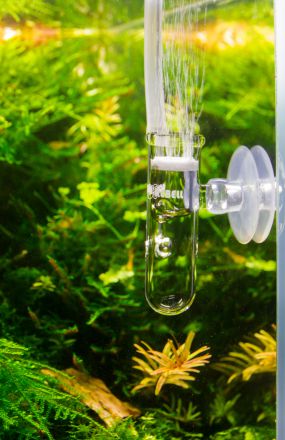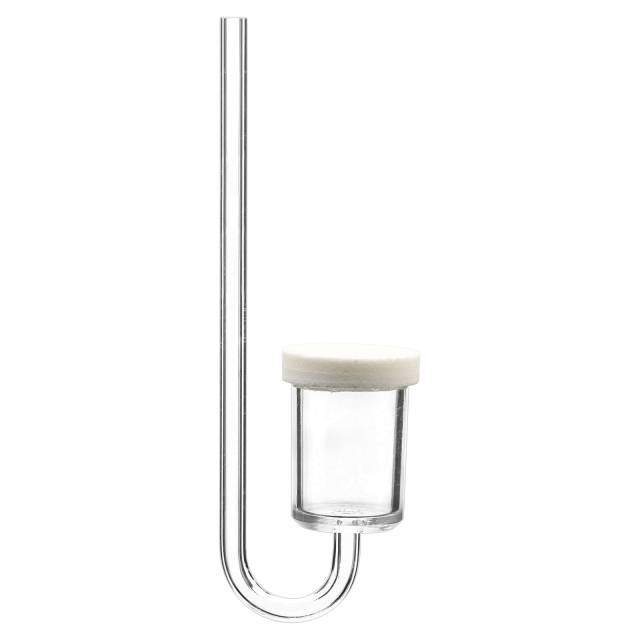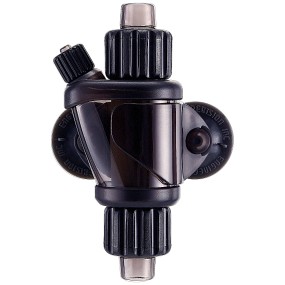Carbon in the form of carbon dioxide (CO2) is one of the most important nutrients for a healthy growth of aquatic plants. Ideally the aquarium gets supplied with carbon dioxide via a CO2 system. The diffuser or atomizer plays a big part in this. Diffusers with a membrane are particularly efficient for this purpose, since they atomize the CO2, i. e. they turn the gas into many tiny bubbles, which facilitates the dissolution of the gas in the aquarium water. For atomization, pressurized CO2 is forced through a finely pored ceramic membrane. Many different membrane diffuser types and designs are available.
We will help you find the right CO2 diffuser for your aquarium.

CO2 system
First of all, it is significant what type of CO2 system is used. Fundamentally people distinguish between systems using compressed gas (with disposable or reusable bottles) and bio CO2. Due to operational reasons, the latter do not produce a particularly high pressure, and the pressure they do produce may fluctuate greatly. Many diffusers need a higher, constant CO2 pressure in order to work optimally. For this reason, low-pressure diffusers are recommended for bio CO2 systems. In our experience, the Air diffusors made by Neo Aquario are highly suitable. They are made of acrylic glass, they are low-noise and they offer a lot of value for the money.

Systems using pressurized gas offer a more constant performance and higher pressure. This opens up a much wider selection of diffusors, most of which need a higher working pressure than bio CO2 can provide. Larger glass or steel diffusors or inline atomizers come to mind.
Tank size
The total water volume of the aquarium to be supplied with CO2 certainly has the biggest influence on the choice of CO2 components. The gross volume of the aquarium is considered when choosing the right diffuser. The larger your tank is, the larger should the diffuser and the diameter of its ceramic membrane be. The CO2 system should work with a correspondingly higher pressure, too.
Smaller-sized diffusers are more than enough for nano aquaria. These small tanks run well on bio CO2. The AQUARIO Neo CO2 diffusor Original is especially small and nice to look at.
In aquaria with a larger volume (500 liters or more) or with an appropriate length (1.50 meters or more), it can make sense to use two diffusers. These are installed on the left and right side of the aquarium and ensure a better, more constant CO2 distribution.
Glass, acrylics or steel?
If you use filter inlets and outlets (Lily Pipes) made of glass or stainless steel in your aquascape or planted tank, it makes a lot of sense to use the same materials when it comes to CO2 tech. Many diffusers and hose connectors (J or U pipes) are available as glass or stainless steel variant. These diffusers are usually equipped with extremely fine-pored membranes, which, depending on the model, are often even replaceable. This facilitates cleaning and repairs.
Our online store also offers diffusers made of acrylic glass or plastic. Those have the benefit of a low price and often come with excellent, fine-pored membranes. These ensure (at a working pressure of 2 bars or more) the formation of extremely small bubbles and thus an excellent solubility of the gas in the water. Models made of acrylic glass are visually highly appealing, whereas colored plastic models might be less unobtrusive.

Invisible CO2 technology
Inline-diffusers are an interesting solution for larger aquaria but also for more puristic aquascaped layouts, in which as little aquarium tech as possible is supposed to be seen. Inline atomizers are installed between the external filter and the outlet in the hose section of the external filter, hidden in the aquarium cabinet.

Inline atomizers are available for all standard hose diameters and hardly influence the flow rate. The atomization of the carbon dioxide gas is even finer in these models and they are absolutely silent. However, a higher working pressure is needed in order for the inline atomizer to operate correctly. We recommend a pressure of 1.8 bar or more.
Only microfine CO2 bubbles that are flushed into the tank from the filter outlet are visible with this type of carbon dioxide feed. (see video).
The quality of the ceramic membrane
The quality of the membrane has a great influence on the solubility of CO2 in the aquarium water. The finer the pores of a membrane are, the better it can produce micro-fine bubbles. Smaller CO2 bubbles have a larger surface-to-volume ratio than larger bubbles. Thus, the gas can dissolve faster in the water (see also: Sukei Research). However, a finer atomization requires a higher working pressure in the CO2 system (often 2 bar are recommended). You as the aquarium keeper should make sure that the components of the CO2 system you use, such as pressure reducer, hose and check valve, are designed to withstand high pressure.
Usually diffusers made of acrylic glass, plastic or stainless steel and inline atomizers as well as higher quality glassware from ADA or Aqua Rebel are equipped with extremely fine-pored membranes. Based on this, we have compiled an overview of the right diffusers for typical aquarium sizes. The suggestions for the respective volume of the aquarium are summarized in a ranking list sorted by recommendability:
Overview: CO2 diffusers
20 to 30 l nano aquarium, Dennerle Scaper's Tank 35 l, Nano Cubes 10, 20 and 30, ADA Mini M:
54 l standard aquarium (60x30x30 cm), Dennerle Scaper's Tank 50 l, Nano Cube 60 or ADA 60-P:
112 l standard aquarium (80x35x40 cm):
182 l standard aquarium (90x45x45 cm), ADA 90-P:
250 l standard aquarium (100x50x50 cm) or 243 l ADA 120-P:
350 to 500 l aquarium: